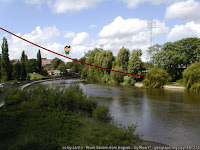Watch the video below, but don't forget to come back here, after watching the video SCROLL ON DOWN THIS PAGE and tell us what you think, by commenting!
Much of the old Shrewsbury we know today, grew out of the wealth of the Tudor period. As we showed in the last video, Shrewsbury flourished for over a century and a half of peace and prosperity.
It was also during this period that the importance of education was realised. A petition in 1542 to Henry VIII from the townspeople of Shrewsbury for a free grammar school, led to the founding of Shrewsbury's best known school. In 1552 Shrewsbury School was founded by the fifteen-year-old King Edward VI.
At first it occupied a house not far from the Castle. Then in the 1590s and 1630s, it gradually expanded into the handsome stone buildings, which are now used as the Library, in Castle Gates, on the road from the station into the town centre.
It was not until many years later, in 1882, that "Shrewsbury School", by then badly in need of larger premises, moved to its present commanding heights, above the southern banks of the River Severn, opposite the park known as the Quarry.
Shrewsbury School is one of the, so called "original seven public schools", as defined by an Act in 1868, and 5 years before that the Clarendon Commission called it one of the 'great' nine schools. Pupils are admitted at the age of 13 by selective examination.
It was originally a boarding school for boys. Girls have been admitted into the Sixth Form since 2008. Since 2014 Shrewsbury School has been fully co-educational. Shrewsbury School's "new site" of 150 acres (61 ha) in Kingsland, is where many famous "Old Salopians" were educated.
These include; The Right Honourable The Lord Heseltine CH PC (born 1933), politician. Michael Palin CBE (born 1943), actor and TV presenter. Nick Owen (born 1947), TV presenter.
Richard Ingrams (born 1937), journalist, founder of Private Eye. Going Back! More Shrewsbury education history!
The Tudor period also saw the transition from wooden-framed buildings to brick and stone. William Rowley built the imposing Rowley's Mansion in 1618. It is said to have been the first brick building in the town. William who was a draper dealing in Welsh cloth, certainly created a lasting landmark for the town, and would no doubt have been proud of its new role.
Moving forward to today.
Rowley's Mansion has become one of the sites housing Shrewsbury's new university.
There are seminar spaces, postgraduate and general teaching spaces, and a University Centre help desk, all in the 16th century building.
Yes! After so many years, the town no longer lacks a university.
Shrewsbury is still not yet officially a "CITY"- Shouldn't it be called a city?
Your comments are welcome!
But, for any viewers who have not recently visited, we can confirm that Shrewsbury is now a University town!
Historical text based upon: The Story of Shrewsbury, by Richard Graves, Hardwick House, Ellesmere 1993.
Now Watch Part 18: The horrors of the English Civil Wars...
Please Comment and Share!





